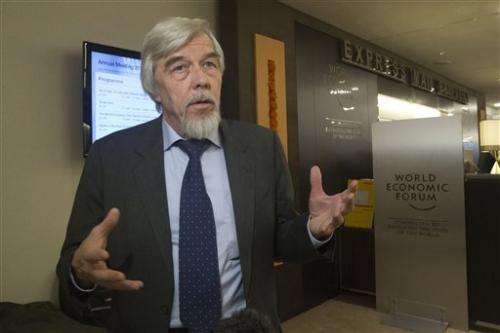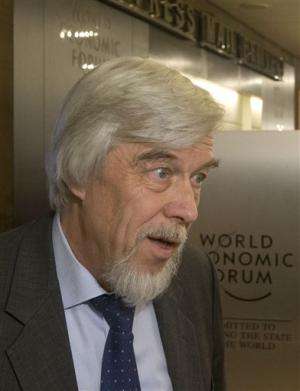Interview: CERN chief firmer on Higgs boson

The world should know with certainty by the middle of this year whether a subatomic particle discovered by scientists is a long-sought Higgs boson, the head of the world's largest atom smasher said Saturday.
Rolf Heuer, director of the European Organization for Nuclear Research, or CERN, said he is confident that "towards the middle of the year, we will be there." By then, he said reams of data from the $10 billion Large Hadron Collider on the Swiss-French border near Geneva should have been assessed.
The timing could also help Scottish physicist Peter Higgs win a Noble Prize, Heuer said in an interview with The Associated Press in the Swiss resort of Davos.
CERN's atom smasher helped scientists declare in July their discovery of a new subatomic particle that Heuer calls "very, very like" a Higgs boson, that promises a new realm of understanding the universe.
The machine, which has been creating high-energy collisions of protons to investigate dark matter, antimatter and the creation of the universe, is being put to rest early this year. The data from it, however, takes longer to analyze.
"Suppose the Higgs boson is a special snowflake. So you have to identify the snowflake, in a big snowstorm, in front of a background of snowfields," Heuer said by way of analogy. "That is very difficult. You need a tremendous amount of snowfall in order to identify the snowflakes and this is why it takes time."

He said the standard model of particle physics describes only 5 percent of the universe, which many theorize occurred in a massive explosion known as the Big Bang.
To explain how subatomic particles, such as electrons, protons and neutrons, were themselves formed, Higgs and others in the 1960s envisioned an energy field where particles interact with a key particle, the Higgs boson.
The idea was that other particles attract Higgs bosons and the more they attract, the bigger their mass will be. But a big question remains: Is this new particle a variation of the Higgs boson, or the same as the Higgs boson that was predicted?
The phrase "God particle," coined by Nobel Prize-winning physicist Leon Lederman, is used by laymen, not physicists, more as an explanation for how the subatomic universe works than how it all started.
"Now, if there is a deviation in one of the properties of this Higgs boson, that means we open a new window, for example, hopefully into the part of the dark universe, the 95 percent of the unknown universe," said Heuer.
"If you find the deviation," he added, "that means if it is not the—but a—Higgs boson, then we might find a fantastic window into the dark universe so we would make another giant leap from the visible to the dark."
Copyright 2013 The Associated Press. All rights reserved. This material may not be published, broadcast, rewritten or redistributed.




















